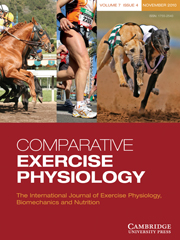Article contents
Training-induced alterations in rump fat thickness and plasma leptin concentration in young mature and old Standardbred mares
Published online by Cambridge University Press: 01 February 2011
Abstract
The objective of this experiment was to test the hypothesis that ageing and training alter plasma concentrations of the peptide hormone leptin. The rationale for the study is based on prior investigations performed at Rutgers University, where published reports documented that ageing disrupts the immune and endocrine responses to acute exercise. The training period for mature young (7.3 ± 0.6 years; n = 6) and old (22 ± 0.7 years; n = 6) (mean ± SE) Standardbred mares was the duration of the summer of 2009 at the Rutgers University Equine Exercise Physiology Laboratory. Mares exercise trained in groups of six in a free-stall motorized circular equine exercise machine for 30 min, three times per week. Each mare performed a graded exercise test before beginning the training, after 8 weeks and after 16 weeks of training. There was no difference in body mass due to age (P>0.10). Training caused an increased body mass in both old and young mares (P < 0.10). There was no effect of training on rump fat thickness; therefore, the increase in body mass was primarily due to an increase in fat-free mass (muscle mass). Old mares had significantly lower plasma leptin at all sample points. As a result of training, plasma leptin was reduced in both old and young mares (P < 0.10). In conclusion, age and training appear to alter the relationship between body composition and leptin.
Information
- Type
- Research Paper
- Information
- Copyright
- Copyright © Cambridge University Press 2011
References
- 5
- Cited by

